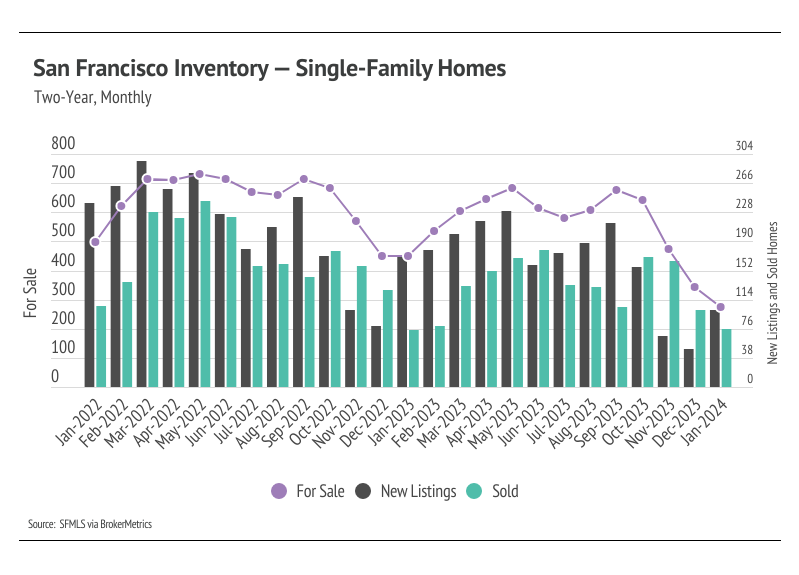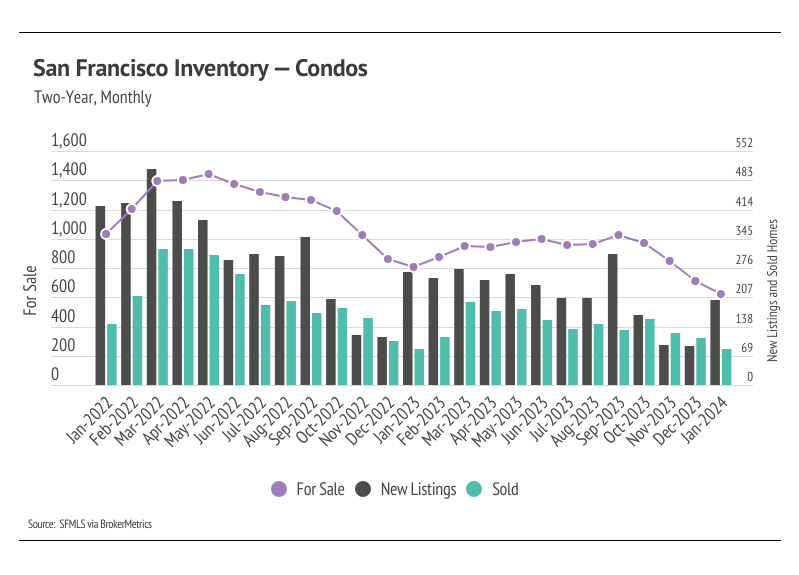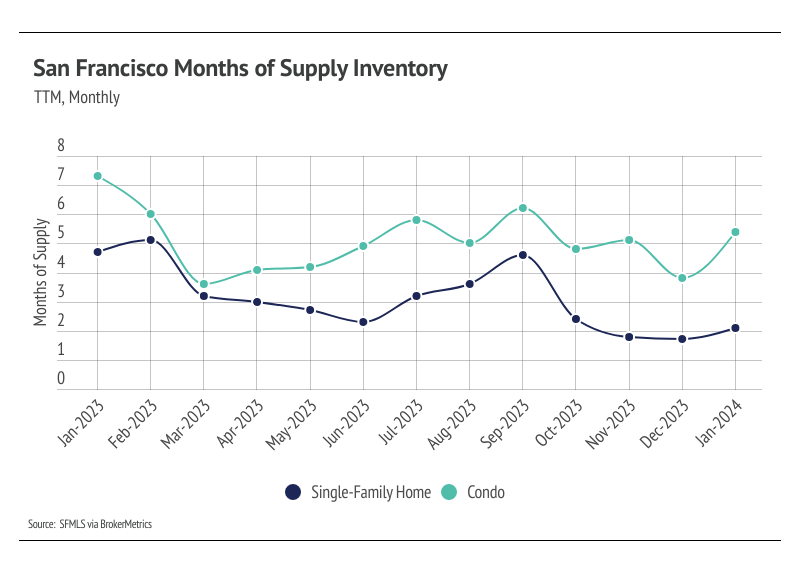Note: You can find the charts/graphs for the Local Lowdown at the end of this section.
In San Francisco, home prices haven’t been largely affected by rising mortgage rates after the initial period of price correction from May 2022 to July 2022. Since July 2022, the median single-family home and condo prices have hovered around $1.5 million and $1.2 million, respectively. Month over month, in January 2024, the median single-family home price rose 13%, while condo prices increased 7%; but, year over year, the median prices were up 18% for single-family homes and 8% for condos. We expect prices to remain fairly stable in the winter months, but as interest rates decline and more sellers come to the market, prices will almost certainly rise in the first half of 2024. Additionally, the sustained downward inventory and low number of new listings will only raise prices as demand grows. More homes, however, must come to the market in the spring and summer to get anything close to a healthy market.
High mortgage rates soften both supply and demand, so ideally, as rates fall, far more sellers will come to the market. Rising demand can only do so much for the market if there isn’t supply to meet it. Unlike 2023 inventory, 2024 inventory has a much better chance of following more typical seasonal patterns.
Single-family home and condo inventory hit all-time lows for the second month in a row
Since the start of 2023, single-family home inventory has followed fairly typical seasonal trends, but at a significantly depressed level, while condo inventory has been in decline since May 2022. Low inventory and fewer new listings have slowed the market considerably. Typically, inventory peaks in July or August and declines through December or January, but the lack of new listings prevented meaningful inventory growth. Last year, sales peaked in May, while new listings and inventory peaked in September. New listings have been exceptionally low, so the little inventory growth throughout the year was driven by fewer sales. In November and December, new listings dropped significantly without a proportional drop in sales, causing inventory to fall to an all-time low, which further highlights how unusual inventory patterns have been over the past year. New listings rose nearly 119% month over month after hitting a record low number of new listings coming to market in December. New listings still couldn’t keep up with sales in January, however, and inventory declined further. Month over month, homes coming under contract increased 37%. Year over year, inventory and new listings are down 27% and 29%, respectively. However, sales are up 1% year over year.
Months of Supply Inventory in December 2023 indicated a sellers’ market for single-family homes and a buyers’ market for condos
Months of Supply Inventory (MSI) quantifies the supply/demand relationship by measuring how many months it would take for all current homes listed on the market to sell at the current rate of sales. The long-term average MSI is around three months in California, which indicates a balanced market. An MSI lower than three indicates that there are more buyers than sellers on the market (meaning it’s a sellers’ market), while a higher MSI indicates there are more sellers than buyers (meaning it’s a buyers’ market). The San Francisco market tends to favor sellers, at least for single-family homes, which is reflected in its low MSI. However, we’ve seen over the past 12 months that this isn’t always the case. MSI has been volatile, moving between a buyers’ and sellers’ market throughout the year. In January, MSI increased, indicating that condos now favor buyers. However, MSI for single-family homes still indicates the market favors sellers.
We can also use percent of list price received as another indicator for supply and demand. Typically, in a calendar year, sellers receive the lowest percentage of list price during the winter months, when demand is lowest. January tends to have the lowest average sale price (SP) to list price (LP), and the summer months tend to have the highest SP/LP. The January 2024 SP/LP was 1% lower than last year, meaning we expect sellers overall to receive a lower percentage of the list price in 2024 than they did in 2023.
Local Lowdown Data







--------------------------
If you are interested in selling, buying or just curious about the
San Francisco and Bay Area real estate market, please give me a call.
We are here to help you and anyone you care about.
--------------------------










